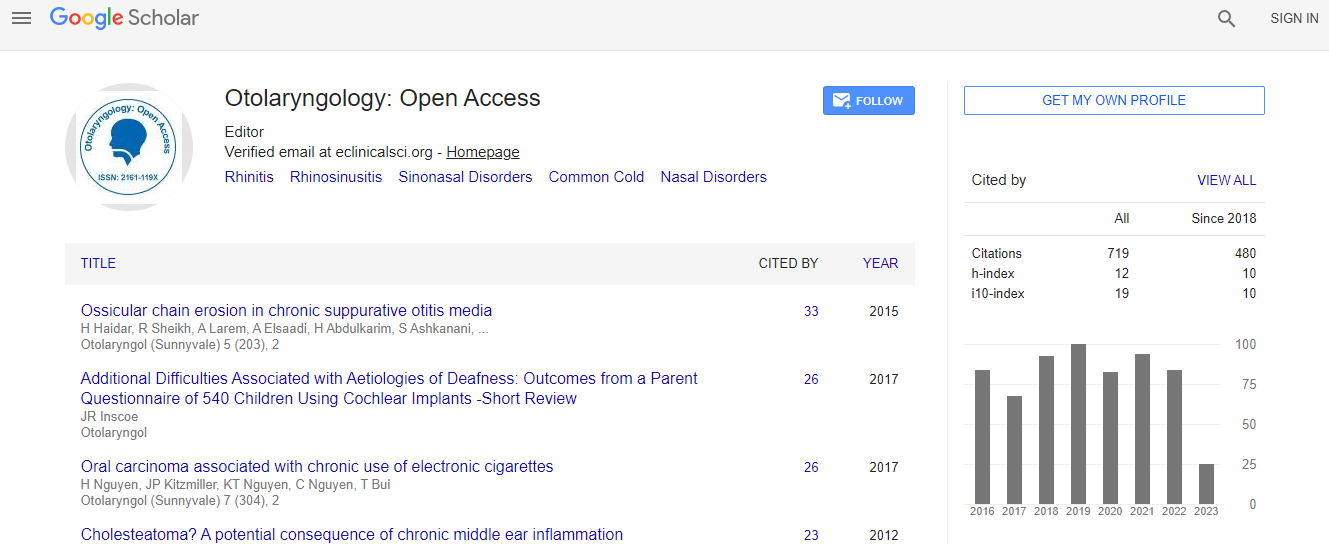Our Group organises 3000+ Global Conferenceseries Events every year across USA, Europe & Asia with support from 1000 more scientific Societies and Publishes 700+ Open Access Journals which contains over 50000 eminent personalities, reputed scientists as editorial board members.
Open Access Journals gaining more Readers and Citations
700 Journals and 15,000,000 Readers Each Journal is getting 25,000+ Readers
Google Scholar citation report
Citations : 925
Otolaryngology: Open Access received 925 citations as per Google Scholar report
Otolaryngology: Open Access peer review process verified at publons
Indexed In
- Index Copernicus
- Google Scholar
- Sherpa Romeo
- Open J Gate
- Genamics JournalSeek
- RefSeek
- Hamdard University
- EBSCO A-Z
- OCLC- WorldCat
- Publons
- Geneva Foundation for Medical Education and Research
- ICMJE
Useful Links
Recommended Journals
Related Subjects
Share This Page
Electrical and speech outcome measures for the evaluation of cochlear implantees
3rd International Conference and Exhibition on Rhinology & Otology
Manal El-Banna, Moural I M, Sobhy O A and Talaat M A
University of Alexandria, Egypt
ScientificTracks Abstracts: Otolaryngology
Abstract
Introduction: Cochlear implant recipients vary in their performance with their implants. One of the reasons of difference in performance might be the number of surviving spiral ganglion cells. Potentials evoked by electrical stimulation of the auditory nerve depend on the degree of synchrony of neural firing. Thus it is expected that cochlear implant recipients who show electrically evoked potentials at different levels of the auditory nervous system might perform better than those who do not. The aim of this study: To record EABR and EMLR from cochlear implant users, investigate consistency over time, investigate the relationship between electrophysiology and MAP psychophysics and correlate the recordings with speech perception scores. Subjects: Twenty four cochlear implanted subjects were recruited from Audiology clinic; Otolaryngology Department, Faculty of Medicine, University of Alexandria, Egypt The inclusion criteria were to have a functioning implant that possessed a bidirectional telemetry feature. Methodology: All subjects underwent the following, (1) detailed history taking medical and surgical, (2) aided free field testing with their implants, (3) electrically evoked potentials recordings, (4) Speech perception testing was performed at the phonetic level using the speech pattern contrast test that tested the ability of cochlear implant users to differentiate between contrasts related to vowels and consonants. Results: Most of the subjects showed responses at one or more electrically evoked potential. Electrophysiological thresholds of EABR were within patients� dynamic ranges and were detected form the first recording time and were generally consistent over time. EMLR was absent in many children before 1 year of implant use. All subjects were able to detect vowels and consonants, however, performance in the discrimination task varied. Comparing different speech perception scores with electrophysiological parameters revealed that the slope of EABR amplitude growth function showed significant correlation with fricative discrimination. Also, EABR latency decreased whereas amplitude increased with increased performance. There was no relationship between the numbers of the electrophysiological levels showing performance and speech perception scores. Conclusion: EABR might serve as a predictor of speech performance at the phonetic level; however, increasing the sample size is required for generalization.Biography
Manal El-Banna has completed her MD in 2005 from Alexandria University and became Assistant Professor in Phoniatrics in 2011. She is a member of IALP since 1998. She is consultant at the Clinical Genomic center since 2010. She has published 13 papers at national and international journals.
Email: manal.albanna@alexmed.edu.eg

 Spanish
Spanish  Chinese
Chinese  Russian
Russian  German
German  French
French  Japanese
Japanese  Portuguese
Portuguese  Hindi
Hindi 
